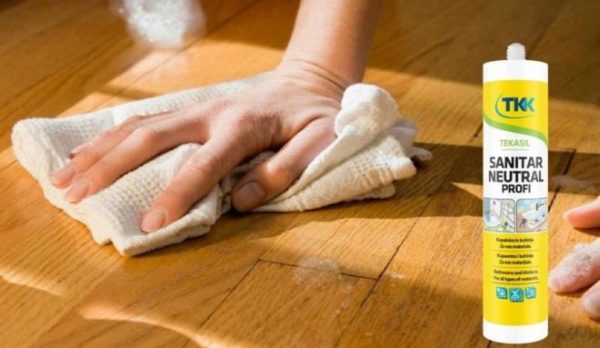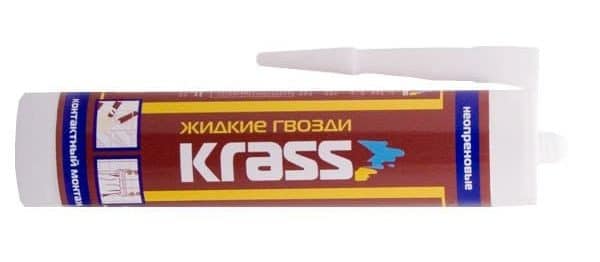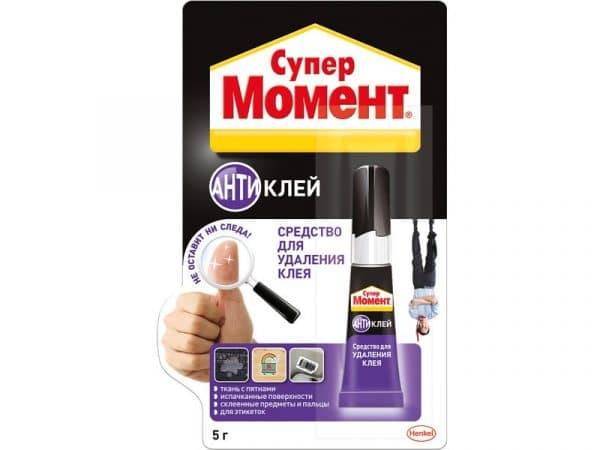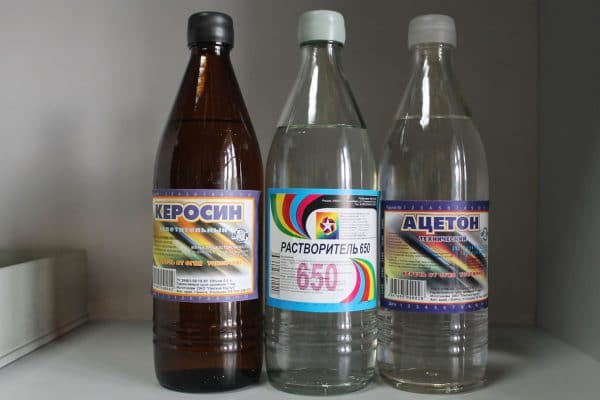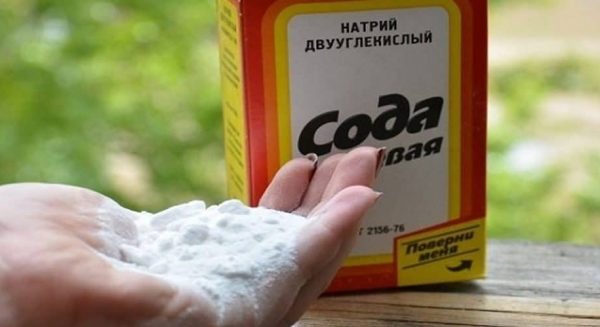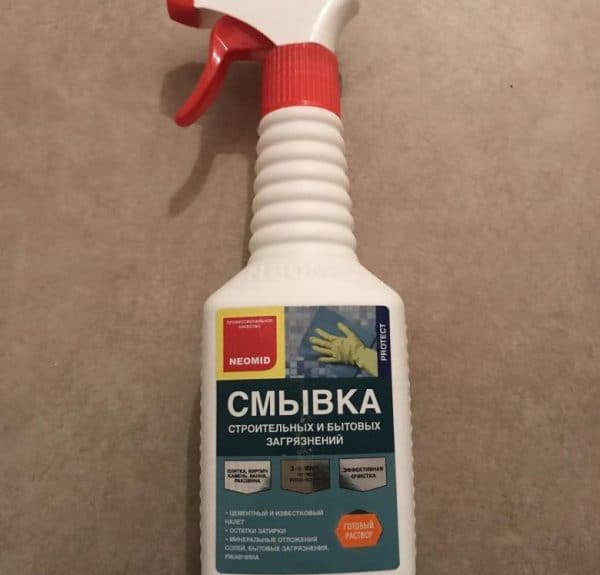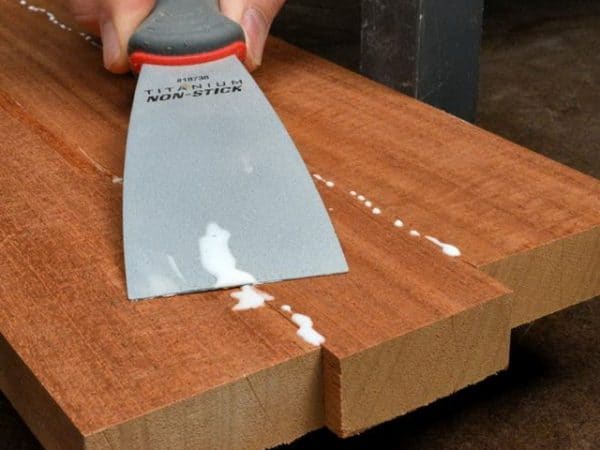At the final stage of repair, when most of the work is completed, dried glue stains are often found. They can “settle” on clothing, various surfaces, and even on the skin of hands. Especially corrosive are liquid nails - polymer adhesives used for reliable and long-term bonding of materials.
- What are liquid nails
- Tools and materials for removing liquid nails
- How to remove liquid nails
- Removing stains from skin, clothing
- Plastic cleaning
- Alternative methods for removing liquid nails
- Heat and cold cleansing
- Special cases
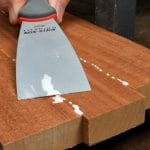
It is not easy to clean such stains: they are not washed with ordinary soap and water. You will have to look for a solvent for liquid nails or use effective improvised means.
to contents ↑What are liquid nails
Liquid nails mean one of the varieties of building glue based on synthetic rubber and polymer compositions. The products also contain fillers: clay, calcium carbonate, titanium dioxide and other strength enhancing additives. The most popular brands are Moment Montage, Macroflex, Titanium.
Traditionally, liquid nails are used for internal work that requires fastening without the use of brackets, screws, screws. This is a universal adhesive composition, which has a high degree of adhesion to such materials:
- tile;
- ceramic tile;
- laminate;
- tree;
- glass;
- plastic;
- drywall;
- metal;
- PVC panels
- linoleum.
In construction stores, you can find two types of liquid nails - neoprene and acrylic. The former give excellent results and instantly adhere to any base, because they contain organic solvents, dry quickly and have high stickiness. Neoprene compounds do not deteriorate from humidity, temperature changes, ideal for bathroom, kitchen. The disadvantage of such liquid nails is significant: they emit a pungent smell, which disappears only after drying.
Acrylic compounds are safe for health because they do not contain toxic solvents. They do not emit any odor, but they dry out an order of magnitude longer and cannot boast of very high adhesion to surfaces. Sensitivity to water, temperature jumps in acrylic compositions is higher, therefore it is undesirable to use them to repair the bathroom, kitchen.
to contents ↑Tools and materials for removing liquid nails
Before you wipe liquid nails from a wall, ceiling or remove from clothing, you should read the instructions for the tool and, at a minimum, clarify its type. Acrylic compounds can be removed more easily than neoprene ones: it is often possible to clean a thing by ordinary scraping. As a rule, manufacturers indicate on the packaging the type of wash that is suitable for removing stains from liquid nails.
Many solvents are sold on the same shelf with adhesives: you can pre-purchase the right product. If the stains of liquid nails are old, a wash will certainly help solve the problem. But all such liquids contain aggressive chemical components, therefore, they require preliminary testing in an inconspicuous area to evaluate the reaction of the material.
You can also remove stains of liquid nails mechanically, for this you will need one or more tools from the list below:
- metal scraper;
- putty knife;
- sharp knife (for example, clerical or construction);
- fishing line;
- thin, strong wire.
to contents ↑For the temperature effect on the stain, you will need a building hair dryer, and for cooling the defect - a household freezer. In order not to harm yourself when working with solvents, you must use personal protective equipment: gloves, glasses, a respirator, and also work in a well-ventilated area.
How to remove liquid nails
For starters, you can try to remove ugly glue stains by mechanical action. If there is a sharp knife, scraper, spatula, they carefully cut them off, scrape off the drip, trying not to damage the base. Stains can be cleaned with layers if they are of significant thickness, picking them up from the edge and tearing them away from the material.
You can remove glue from linoleum, laminate, PVC panels using wire. You must act in this way:
- pick up a hard wire;
- try to pierce with it an accumulation of cured glue closer to the surface of the base material;
- pull the wire forward so that you can take it at both ends;
- move the wire with your hands in any direction, causing crumbling and detachment of liquid nails until it is completely separated from the base.
to contents ↑The remaining traces should be wiped and washed with detergents, cleaning products that are available. Often this is done with plain water, especially if the stain is fresh and has not had time to dry completely.
Removing stains from skin, clothing
The skin of the hands is usually contaminated by careless work with liquid nails, ignoring the use of gloves. Acrylic-based nails can be washed off well with soap and water. In addition, you can use body scrubs, which have hard particles and easily scrape off all impurities. If you can’t remove the neoprene composition from the skin, carefully rub vegetable oil, a baby or other oily cream, petroleum jelly into the dirty area, then clean it with a scrub.
It is difficult to wash off stains of such high-strength glue from clothes and fabrics. Acrylic compounds can be dissolved with acetone, white spirit, then thoroughly wash the item with ordinary powder. Traces of neoprene glue on textiles are eaten literally tight, and the use of chemical washes can permanently ruin a thing. If it was not possible to remove fresh stains of glue from furniture, textiles, it is worth trying acetone or fatty oils in an inconspicuous area or carefully scrubbing the stain in pieces mechanically.
to contents ↑Plastic cleaning
It’s easier to clean dirty stains from plastic than from cloth. However, some varieties of plastic products do not respond well to solvents and washes, so use them with caution. You can also wipe glue stains with plastic from petroleum jelly, oil, turpentine, and then wash with detergent. Replace the solvent with acetone-based nail polish remover, which is rubbed into the contaminated area until the liquid nails soften. To remove the stain, Dimexide is also suitable - a pharmacy that dissolves glue in a matter of minutes.
To reduce the risk of damage to the plastic surface with liquid nails, you need to use these tips:
- Before work, it is good to cover things with cellophane, newspapers;
- if a drop of glue gets on the product, immediately wipe it with a dry cloth, and then wash it with soap;
- never wait for the glue to dry, but clean it fresh, without smearing the stain on the surrounding areas.
Alternative methods for removing liquid nails
If there is no time or money to buy a special wash, you can try unconventional methods for removing glue stains from solid substrates:
- Moisten a cotton swab with butter or margarine, treat the stain well.Then wash the surface with soap.
- Sprinkle a trace of liquid nails with table vinegar (6-9%), give the product time to act (usually 15-30 minutes), then scrape off the acid-softened stain.
- Moisten a kitchen sponge, squeeze well, sprinkle with plenty of soda. Wipe off the glue stain with this powder until it disappears completely.
- Put a rag abundantly dampened with water on the stain, leave for an hour. Then remove the liquid nails with pumice for the feet. Care must be taken not to damage the surface of the product.
Heat and cold cleansing
To get rid of solidified liquid nails, physical methods can be used - heating and cooling. The spot softens well from warming with a building hair dryer, and it can be eliminated with an ordinary rag. To heat the contaminated area, you need to cover it with a cloth, then expose it to hot air for as long as it takes to melt the glue. Part of it will be absorbed into the flap, the rest will need to be quickly wiped off.
to contents ↑Another physical method of exposure is spot freezing. It is especially convenient to use it when textiles and removable furniture upholstery are contaminated. The easiest way is to put a thing in a bag, put in a freezer for a couple of hours, then crush the liquid nails with your hands and remove the pieces. If it is impossible to place the product in the freezer, it is allowed to cover it with ice and then clean it in the same way.
Special cases
Sometimes a glue blot appears on the ceiling, for example, when gluing PVC panels. In this situation, it is worth investing in a special wash, because on the ceiling you need to work carefully and for sure, otherwise the mark from the spot will immediately catch your eye. The flap of the fabric is moistened with a solvent, glued to the place of contamination, incubated for an hour, then cleaned, glue residue wiped off.
When cleaning silicate, organic glass from liquid nails, they work extremely carefully: the slightest scratch will spoil the appearance of the product. Do not use abrasive products or too aggressive washes: it is better to try rubbing with acetone using a soft sponge. After removing the stain, the surface is washed with soft SMS, non-abrasive detergents and wiped dry to make it look like new.

